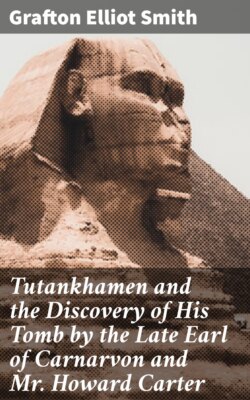Читать книгу Tutankhamen and the Discovery of His Tomb by the Late Earl of Carnarvon and Mr. Howard Carter - Grafton Elliot Smith - Страница 4
На сайте Литреса книга снята с продажи.
BIBLIOGRAPHICAL NOTE
ОглавлениеTable of Contents
The only accurate and reliable account that has ever been given of the Egyptian funerary practices and their significance is Dr Alan Gardiner’s introductory memoir on The Tomb of Amenemhēt (illustrated by Nina de Garis Davies) which was published in 1915 under the auspices of the Egypt Exploration Fund (now Society).
Dr Gardiner describes the actual condition of affairs found in a private Theban tomb of the eighteenth dynasty (in the reign of Thothmes III, about a century earlier than Tutankhamen); and in the light of his intimate knowledge and understanding of the literature of the period, he interprets the meaning of the arrangement of the tomb and especially of the scenes and inscriptions sculptured and painted upon the walls, which Mrs de Garis Davies has reproduced with such skill and accuracy. This unique work is indispensable to anyone who wants to read what the ancient Egyptians themselves actually wrote to express their beliefs or interpret their customs. Professor James H. Breasted’s History of Egypt and Development of Religion and Thought in Ancient Egypt are the best guides to a knowledge of the history and religion of ancient Egypt. The late Sir Gaston Maspero’s Egyptian Art (London, 1913) contains a great deal of information directly relevant to the interpretation of objects in Tutankhamen’s tomb. But Mr Burton’s photographs of Tutankhamen’s funerary equipment give a new interest and value to Birch’s edition of Sir Gardner Wilkinson’s The Manners and Customs of the Ancient Egyptians (London, 1878), for many of the objects and funeral scenes depicted in that remarkable book enable us to form a mental picture of the Valley of the Tombs as the funeral of Tutankhamen wound its way to the place where Mr Howard Carter has just brought to light so many articles closely analogous to those depicted in Birch’s and Wilkinson’s book.
All the information at present available concerning the life of Tutankhamen and Horemheb, his successor once removed, was collected and published (in 1912) by the late Sir Gaston Maspero, The Tombs of Harmhabi and Touatânkhamanou (Theodore M. Davis’ Excavations).
The other volumes of reports published by Mr Theodore Davis are valuable for reference and comparison in studying the results of the exploration of Tutankhamen’s tomb. The two volumes, The Tomb of Iouiya and Touiyou (1907) and The Tomb of Queen Tiyi (1910) are specially important, and relevant to the discoveries in Tutankhamen’s tomb. Mr Arthur Weigall’s book The Life and Times of Akhnaton gives a popular and romantic picture of his conception of the history of the times of Tutankhamen and his father-in-law.
